A Future Study of an Environment Driving Force (EDR): The Impacts of Urmia Lake Water-Level Fluctuations on Human Settlements
Abstract
:1. Introduction
2. Study Design and Methods
2.1. Model Region: Lake Urmia Basin, Iran
2.2. Methodology
2.2.1. Delphi Survey: Foresight Desirability
- Round 1: In the first Delphi round, key experts were identified. There are no clear guidelines on the number of participants included in studies that use Delphi questioning as the sample is purposively selected, depending on the problem being studied [26]. Some studies have used 15 participants, while others have used 60 [27]. In this paper, the target panel of experts included 35 people (Table 2). They were selected based on published papers (also five people who have worked on the Aral Sea); recommendations by other scientists; and consultations with directors of scientific institutions, such as the Lake Urmia restoration program (ULRP), the Urmia Lake research Institute, and Urmia and Tabriz Universities. Except for five people (X11, 12, 13, 15, and 17), all experts had local knowledge (village level) and regional knowledge (research across districts).
- Round 2: The second round was conducted with experts at Urmia Lake Restoration Centre. Nine experts (25.71% response rate) participated in the second round. In this round, the results of the first round were discussed. Finally, 17 environmental consequences were selected, which were agreed upon by the panel members.
- Round 3: The third round was also via email. We emailed 17 environmental consequences (which had been agreed upon in Round 2) to all 35 participants, and 27 experts participated in Round 3 (77.14% response rate). After applying some changes by the respondents, the results of the expert responses were summarized in Table 3.
2.2.2. Cross-Impact Analysis: MICMAC
- Definition of system variables—the system variables are determined using expert opinions, brainstorming, and a literature review. At this point, the result is a jumbled list of consequenses.
- Identification of the relationships among the variables—the second stage is to specify the link between the variables after they have been identified. Table 4 shows the matrix of direct influence (MDI) is the name given to this matrix. Each MDIi j cell illustrates how much variable I influences variable j. For this purpose, the initial matrix was forwarded to experts for classification. Five members (14.29%) of the expert panel participated in this step. The grading was carried out as follows.
- 3.
3. Results
4. Discussion
5. Conclusions
Author Contributions
Funding
Institutional Review Board Statement
Informed Consent Statement
Data Availability Statement
Conflicts of Interest
References
- Williams, W.D. Environmental threats to salt lakes and the likely status of inland saline ecosystems in 2025. Environ. Conserv. 2002, 29, 154–167. [Google Scholar] [CrossRef] [Green Version]
- Hassani, A.; Azapagic, A.; D’Odorico, P.; Keshmiri, A.; Shokri, N. Desiccation crisis of saline lakes: A new decision-support framework for building resilience to climate change. Sci. Total. Environ. 2020, 703, 134718. [Google Scholar] [CrossRef] [PubMed]
- Messager, M.L.; Lehner, B.; Grill, G.; Nedeva, I.; Schmitt, O. Estimating the volume and age of water stored in global lakes using a geo-statistical approach. Nat. Commun. 2016, 7, 1–11. [Google Scholar] [CrossRef] [PubMed]
- Heydari, N.; Jabbari, H. Worldwide Environmental Threats to Salt Lakes. Int. J. Des. Nat. Ecodynamics 2012, 7, 292–299. [Google Scholar] [CrossRef] [Green Version]
- Wurtsbaugh, W.A.; Miller, C.; Null, S.E.; DeRose, R.J.; Wilcock, P.; Hahnenberger, M.; Howe, F.; Moore, J. Decline of the world’s saline lakes. Nat. Geosci. 2017, 10, 816–821. [Google Scholar] [CrossRef]
- Pekel, J.F.; Cottam, A.; Gorelick, N.; Belward, A.S. High-resolution mapping of global surface water and its long-term changes. Nature. 2016, 540, 418–422. [Google Scholar] [CrossRef]
- Gross, M. The world’s vanishing lakes. Curr. Biol. 2017, 27, 43–46. [Google Scholar] [CrossRef]
- Nicoll, K.; Hahnenberger, M.; Goldstein, H.L. ‘Dust in the wind ‘from source-to-sink: Analysis of the 14–15 April 2015 storm in Utah. Aeolian Res. 2020, 46, 100532. [Google Scholar] [CrossRef]
- Micklin, P. The future Aral Sea: Hope and despair. Environ. Earth Sci. 2016, 75, 844. [Google Scholar] [CrossRef]
- Mischke, S.; Liu, C.; Zhang, J.; Zhang, C.; Zhang, H.; Jiao, P.; Plessen, B. The world’s earliest Aral-Sea type disaster: The decline of the Loulan Kingdom in the Tarim Basin. Sci. Rep. 2017, 7, 1–8. [Google Scholar] [CrossRef]
- Case, H.L.I.; Boles, J.; Delgado, A.; Nguyen, T.; Osugi, D.; Barnum, D.A.; Decker, D.; Steinberg, S.; Steinberg, S.; Keene, C.; et al. Salton Sea Ecosystem Monitoring and Assessment Plan; Open File Report 2013,1133; U.S. Geological Survey: Reston, VA, USA, 2013.
- Stone, R. Saving Iran’s great Salt Lake. Science 2015, 349, 1044–1047. [Google Scholar] [CrossRef]
- Ministry of Energy (Iran). Daily Rainfall Report for First and 2nd Level Catchments. 2021. Available online: http://wrs.wrm.ir/m3/gozaresh_print.asp (accessed on 22 August 2021).
- Jahanbakhsh, S.; Adalatdost, M.; Tadayoni, M. Urmia Lake: The Relationship between Sunspots and Climate on the Northwestern of Iran. Geogr. Res. Q. 2011, 25, 16656–16684. [Google Scholar]
- Zoljoodi, M.; Didevarasl, A. Water-Level Fluctuations of Urmia Lake: Relationship with the Long-Term Changes of Meteorological Variables (Solutions for Water-Crisis Management in Urmia Lake Basin). Atmos. Clim. Sci. 2014, 4, 358–368. [Google Scholar] [CrossRef] [Green Version]
- Sima, S.; Rosenberg, D.E.; Wurtsbaugh, W.A.; Null, S.E.; Kettenring, K.M. Managing Lake Urmia, Iran for diverse restoration objectives: Moving beyond a uniform target lake level. J. Hydrol. Reg. Stud. 2021, 35, 100812. [Google Scholar] [CrossRef]
- Urmia Lake Restoration National Committee. Necessity of Lake Urmia Resuscitation, Causes of Drought and Threats; Report No: ULRP-6-4-3-Rep 1; Urmia Lake Restoration National Committee: Tehran, Iran, 2015. [Google Scholar]
- Ghale, Y.A.G.; Baykara, M.; Unal, A. Investigating the interaction between agricultural lands and Urmia Lake ecosystem using remote sensing techniques and hydro-climatic data analysis. Agric. Water Manag. 2019, 221, 566–579. [Google Scholar] [CrossRef]
- Mohammadi Hamidi, S.; Nazmfar, H.; Ahad, R.; Yazdani, M.H. Futurology of the Economic Drivers of Urmia Lake Water Level Fluctuations on the Spatial Unbalanced. J. Spat. Plan. 2020, 24, 69–97. [Google Scholar]
- Panula-Ontto, J.; Luukkanen, J.; Kaivo-Oja, J.; O’Mahony, T.; Vehmas, J.; Valkealahti, S.; Björkqvist, T.; Korpela, T.; Järventausta, P.; Majanne, Y.; et al. Cross-impact analysis of Finnish electricity system with increased renewables: Long-run energy policy challenges in balancing supply and consumption. Energy Policy 2018, 118, 504–513. [Google Scholar] [CrossRef]
- Buehring, J.; Bishop, P.C. Foresight and Design: New Support for Strategic Decision Making. She Ji Des. Econ. Innov. 2020, 6, 408–432. [Google Scholar] [CrossRef]
- Jouan, J.; Ridier, A.; Carof, M. Legume production and use in feed: Analysis of levers to improve protein self-sufficiency from foresight scenarios. J. Clean. Prod. 2020, 274, 123085. [Google Scholar] [CrossRef]
- Gariboldi, M.I.; Lin, V.; Bland, J.; Auplish, M.; Cawthorne, A. Foresight in the time of COVID-19. Lancet Reg. Health-West. Pac. 2021, 6, 100049. [Google Scholar] [CrossRef]
- Ecken, P.; Gnatzy, T.; Heiko, A. Desirability bias in foresight: Consequences for decision quality based on Delphi results. Technol. Forecast. Soc. Chang. 2011, 78, 1654–1670. [Google Scholar] [CrossRef]
- Aschemann-Witzel, J.; Perez-Cueto, F.J.; Niedzwiedzka, B.; Verbeke, W.; Bech-Larsen, T. Transferability of private food marketing success factors to public food and health policy: An expert Delphi survey. Food Policy 2012, 37, 650–660. [Google Scholar] [CrossRef]
- Shariff, N. Utilising the Delphi survey approach: A review. J. Nurs. Care 2015, 4, 246. [Google Scholar] [CrossRef]
- Powell, C. The Delphi technique: Myths and realities. J. Adv. Nurs. 2003, 41, 376–382. [Google Scholar] [CrossRef] [PubMed] [Green Version]
- Swarnakar, V.; Tiwari, A.K.; Singh, A.R. Evaluating critical failure factors for implementing sustainable lean six sigma framework in manufacturing organisation. Int. J. Lean Six Sigma 2020. [Google Scholar] [CrossRef]
- Villacorta, P.J.; Masegosa, A.D.; Castellanos, D.; Lamata, M.T. A new fuzzy linguistic approach to qualitative Cross Impact Analysis. Appl. Soft Comput. 2014, 24, 19–30. [Google Scholar] [CrossRef]
- Kinker, P.; Swarnakar, V.; Singh, A.R.; Jain, R. Identifying and evaluating service quality barriers for polytechnic education: An ISM-MICMAC approach. Mater. Today Proc. 2020, 46, 9752–9757. [Google Scholar] [CrossRef]
- Asem, A.; Eimanifar, A.; Djamali, M.; De los Rios, P.; Wink, M. Biodiversity of the hypersaline Urmia Lake national park (NW Iran). Diversity 2014, 6, 102–132. [Google Scholar] [CrossRef] [Green Version]
- Nikjoo, B.; Abdeshahi, A.; Yazdanpanah, M. Prioritising the economic, social and environmental consequences on rural areas of Malekan township of the drying of lake Urmia. Environ. Sci. 2017, 15, 27–44. (In Persian) [Google Scholar]
- Soleimani Ziveh, M. Health and Environmental Consequences of Lake Urmia Water Loss, Comparative Comparison with Similar cases. In Proceedings of the Thirteenth National Conference on Environmental Health, Kerman, Iran, 2 November 2010. (In Persian). [Google Scholar]
- Ebrahimzadeh, A.; Hssani, A.R.; Farnoodfar, R. Investigating the drying of Lake Urmia and environmental pollutions and its impact on the economy. In Proceedings of the First Conference of Environmental Pollution, Ardabil, Iran, 13 May 2014. (In Persian). [Google Scholar]
- Mohammadi Hamidi, S.; Nazmfar, H.; Yazdani, M.H.; Rezayan Ghyeh Bashi, A. An Investigation and Analysis of the Effect of Urmia Lake Water Level Reduction on the Development Levels of Surrounding Counties. Town Ctry. Plan. 2019, 11, 285–309. (In Persian) [Google Scholar]
- Asghari-Kaljahi, E.; Hoseinpour, S.; Nadiri, A.O. Evaluation of salt dust occurrence potential in the Northeast Zone of Urmia Lake. Environ. Eros. Res. 2018, 8, 42–61. (In Persian) [Google Scholar]
- Musapour, J.; Dastgiri, S.; Asghari Jafarabadi, M.; Ziasarabi, P.; Khamnian, J. The environmental health catastrophe in Lake Urmia and asthma disease: A cohort study. Electron. J. Gen. Med. 2019, 16, em147. (In Persian) [Google Scholar] [CrossRef]
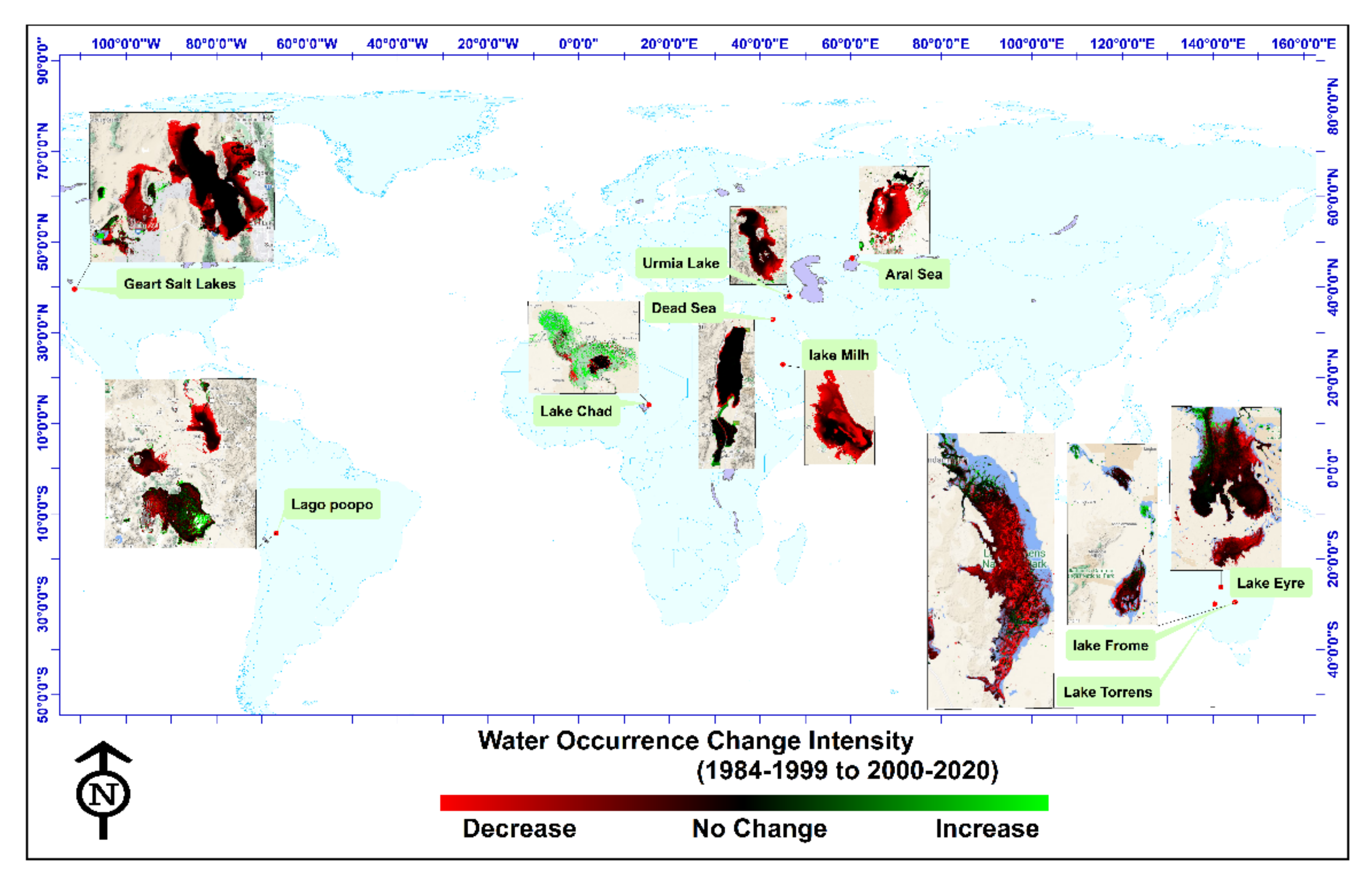
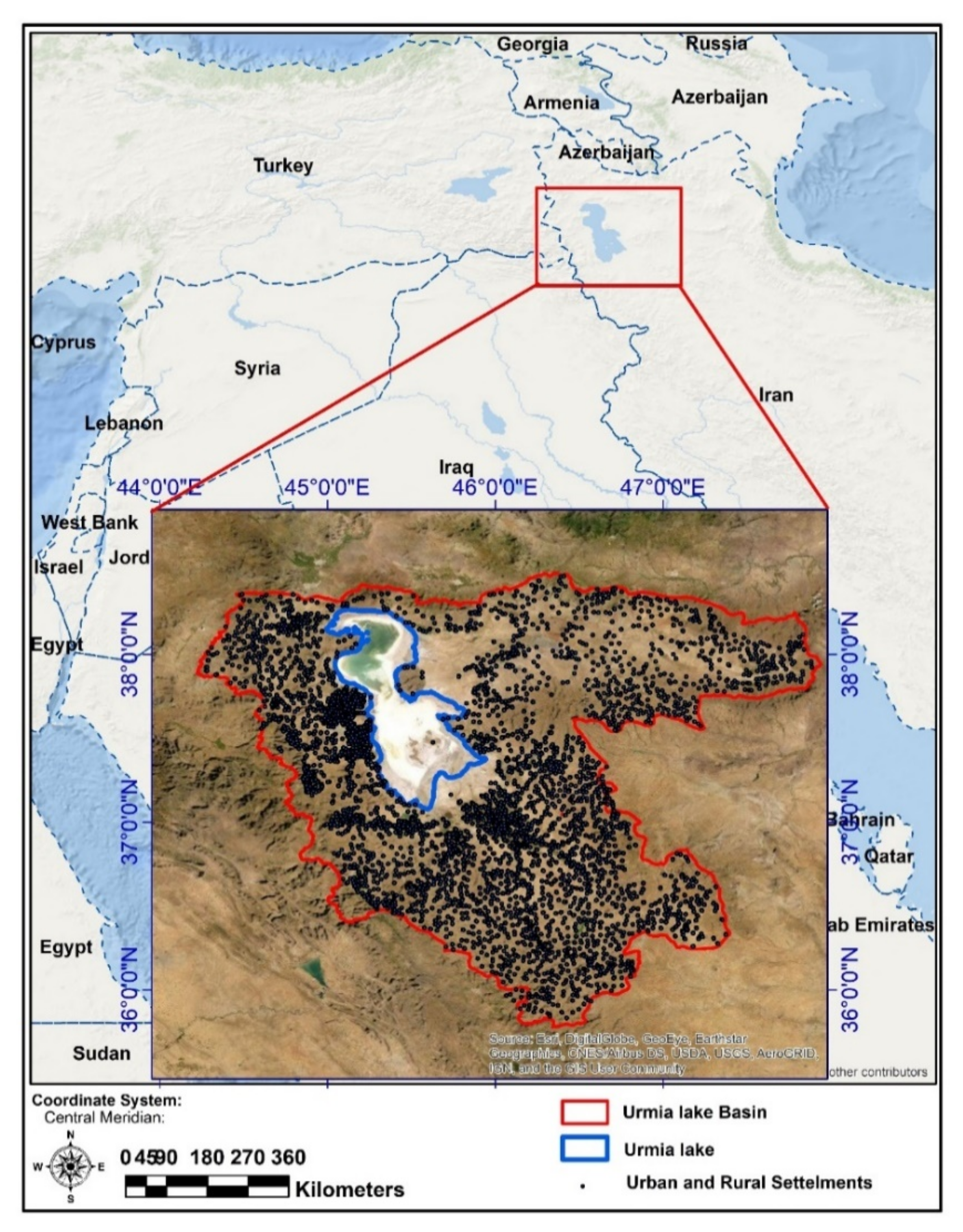

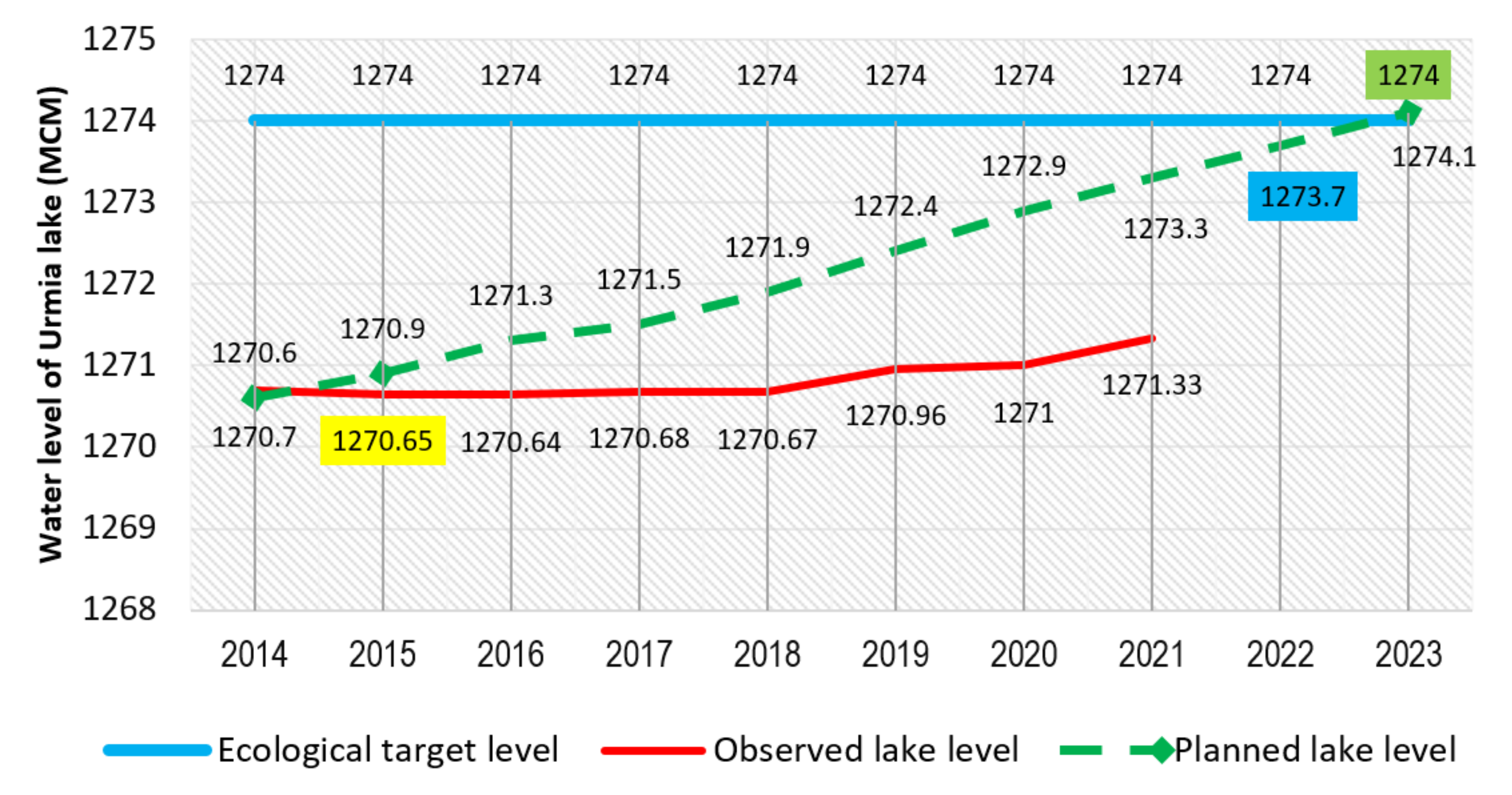
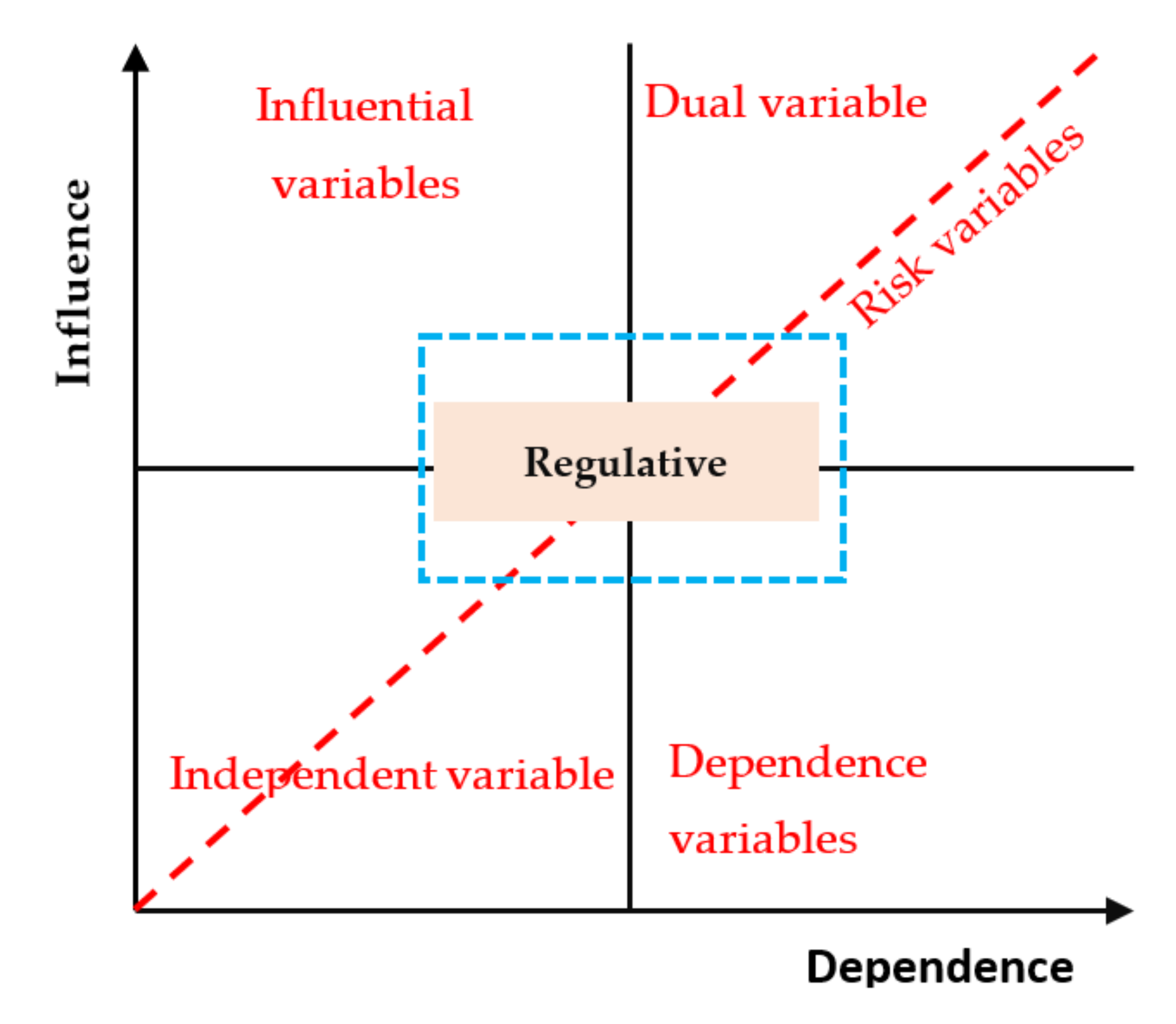
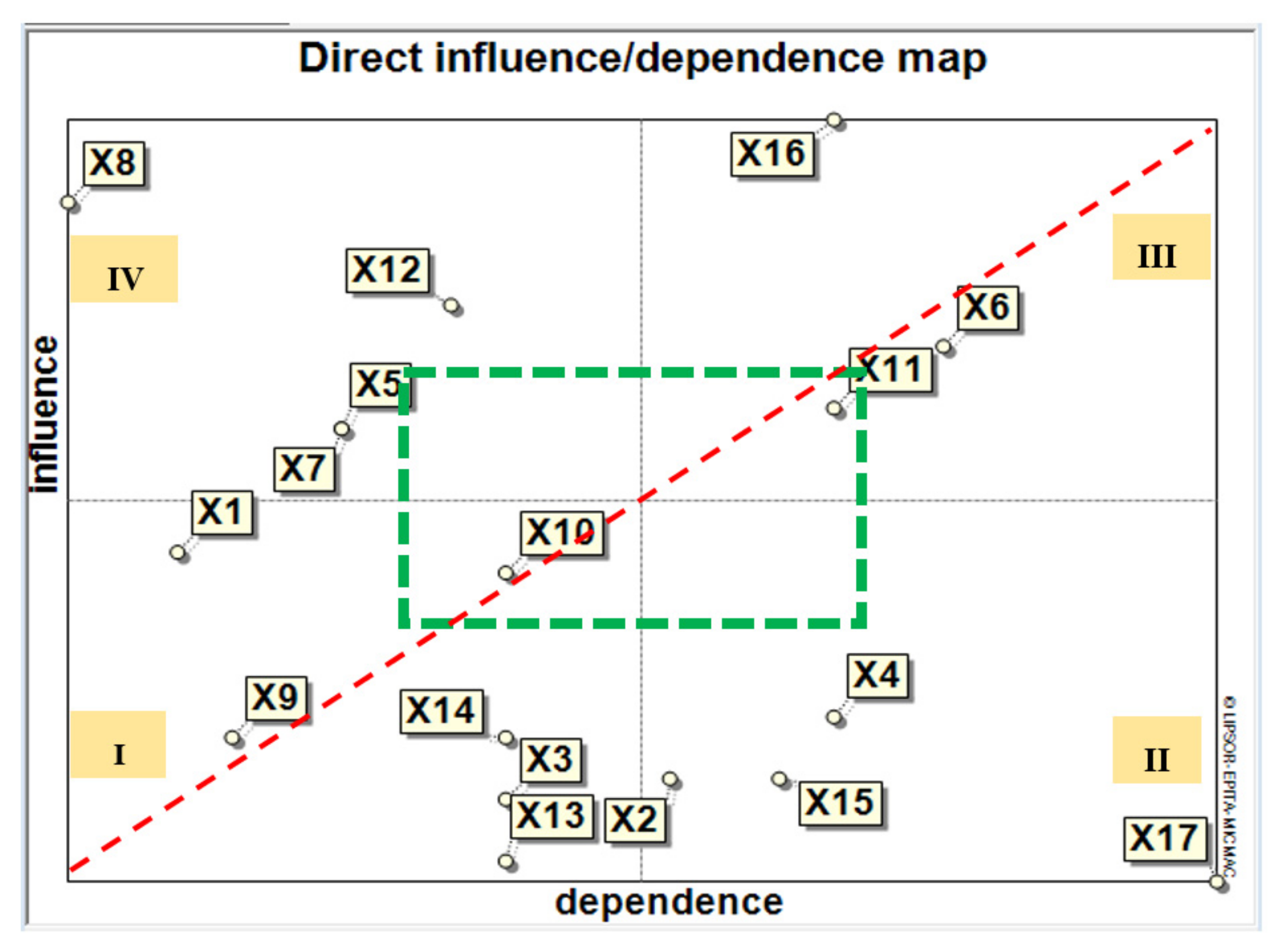
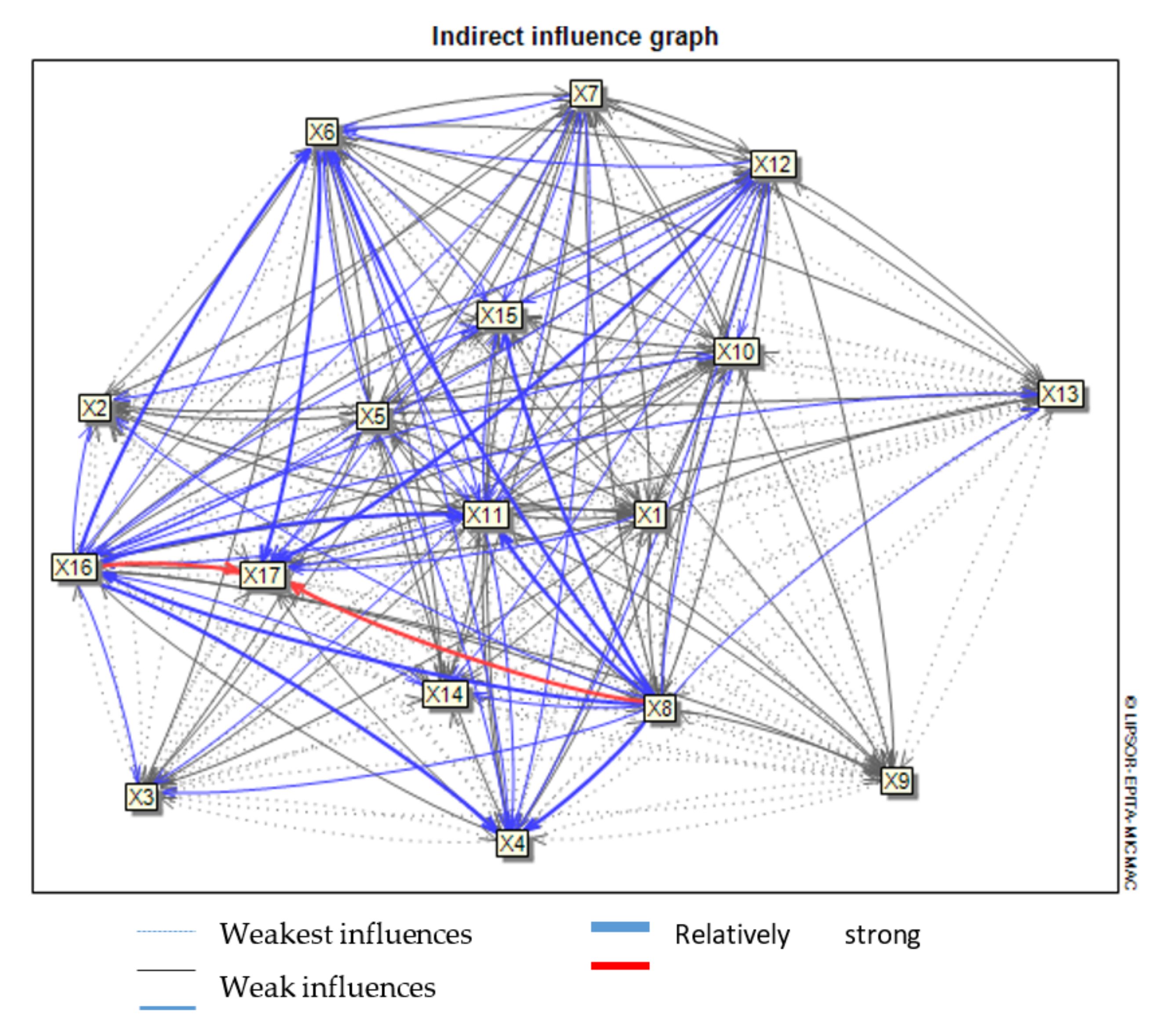
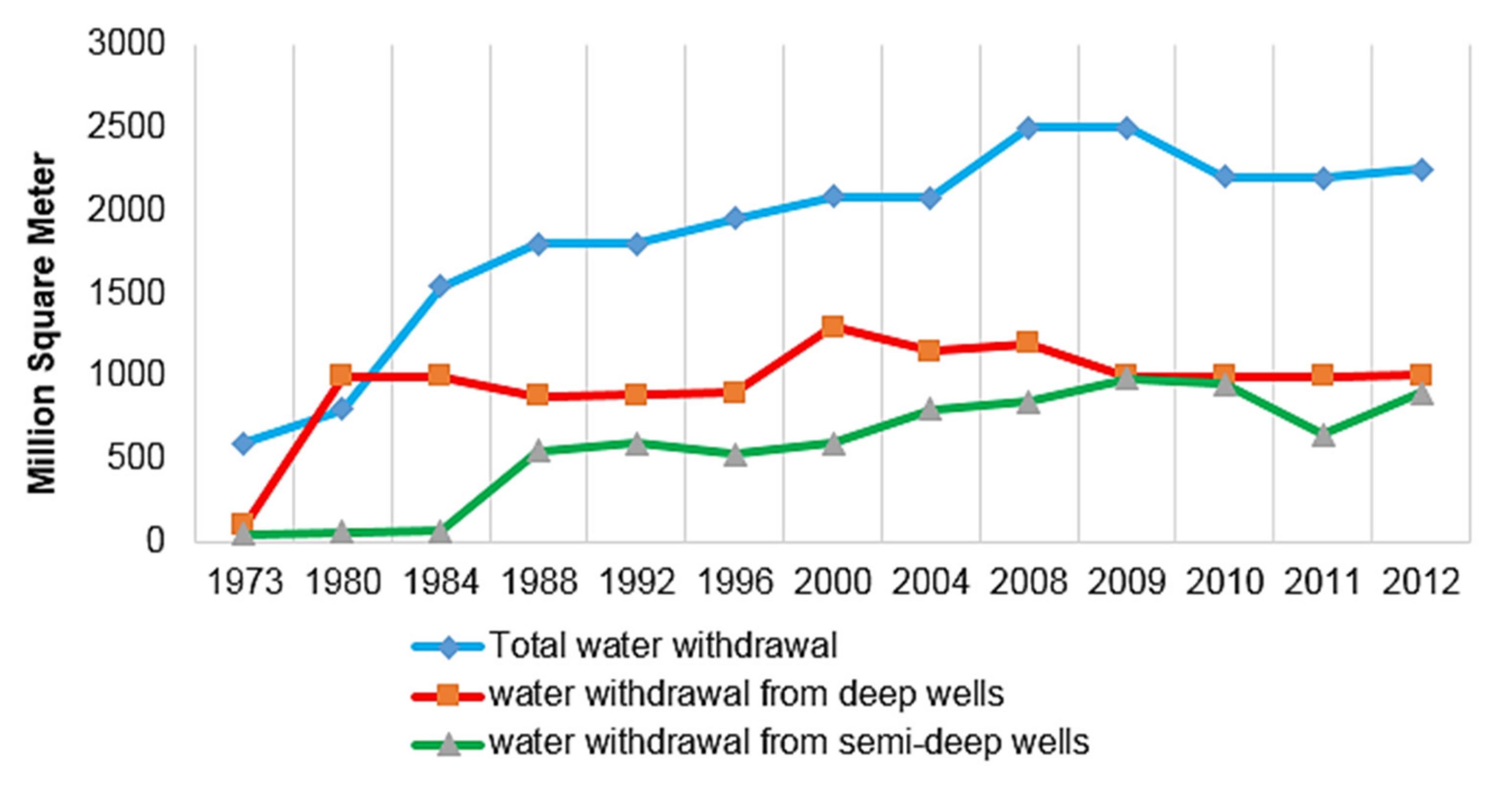
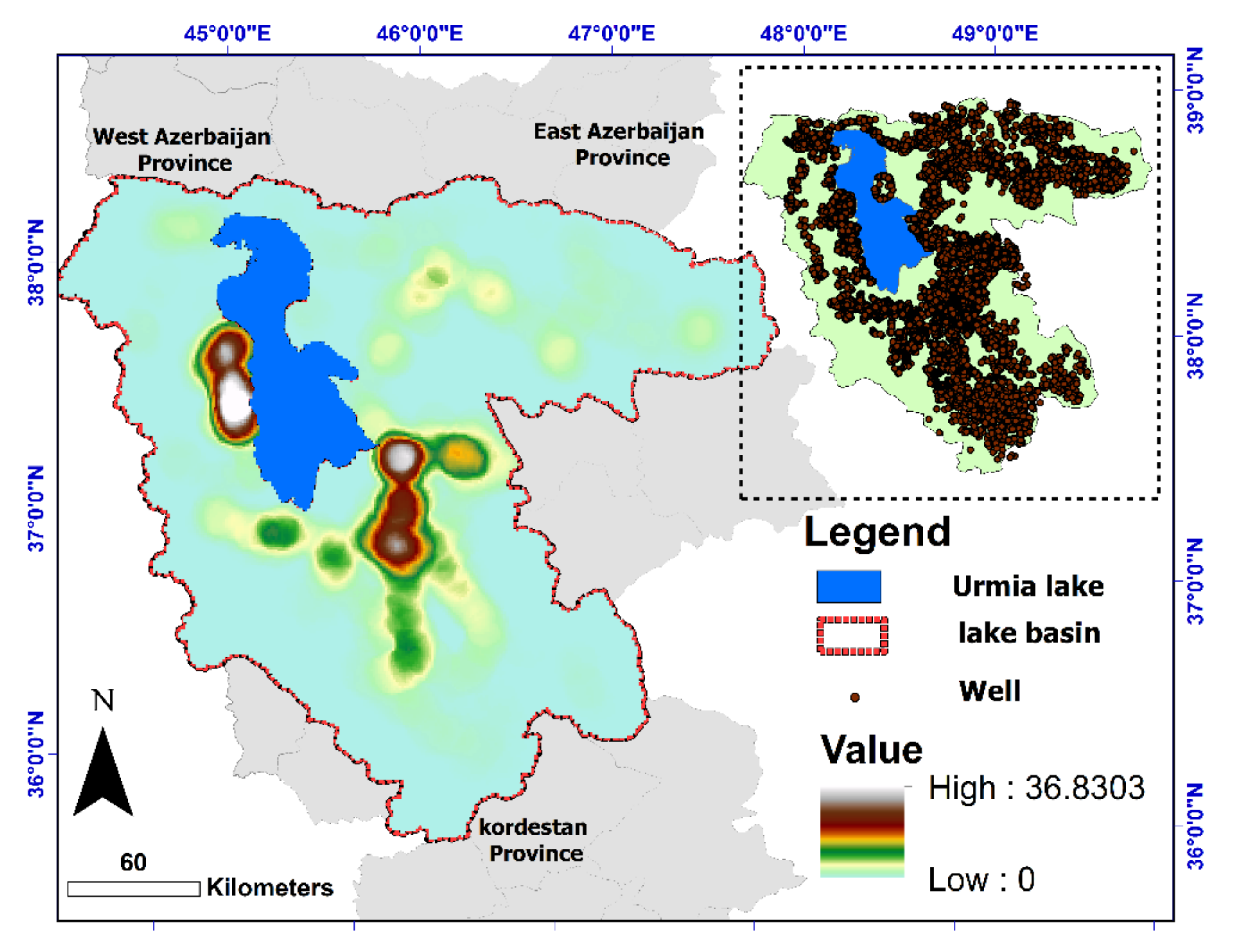
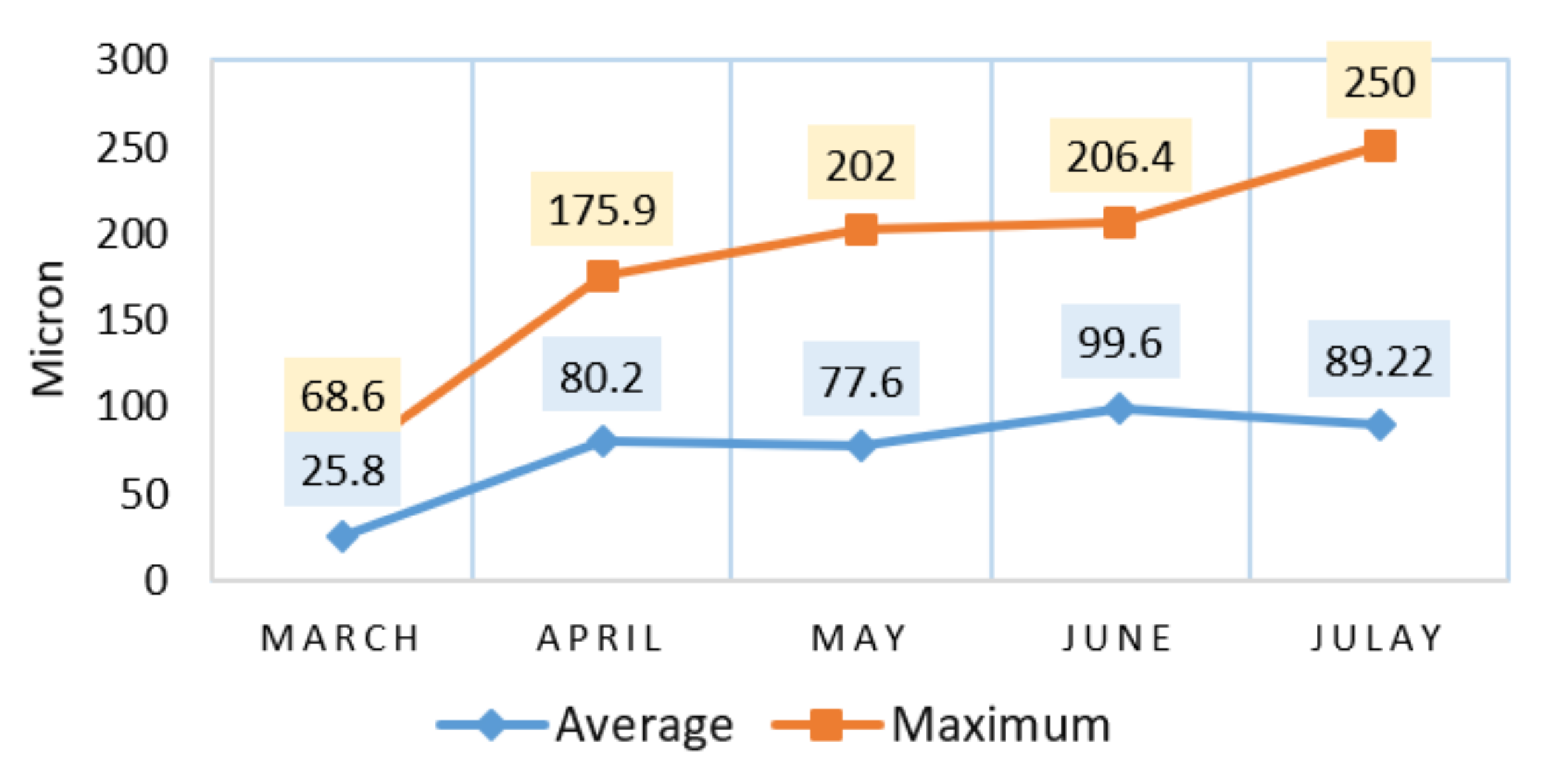
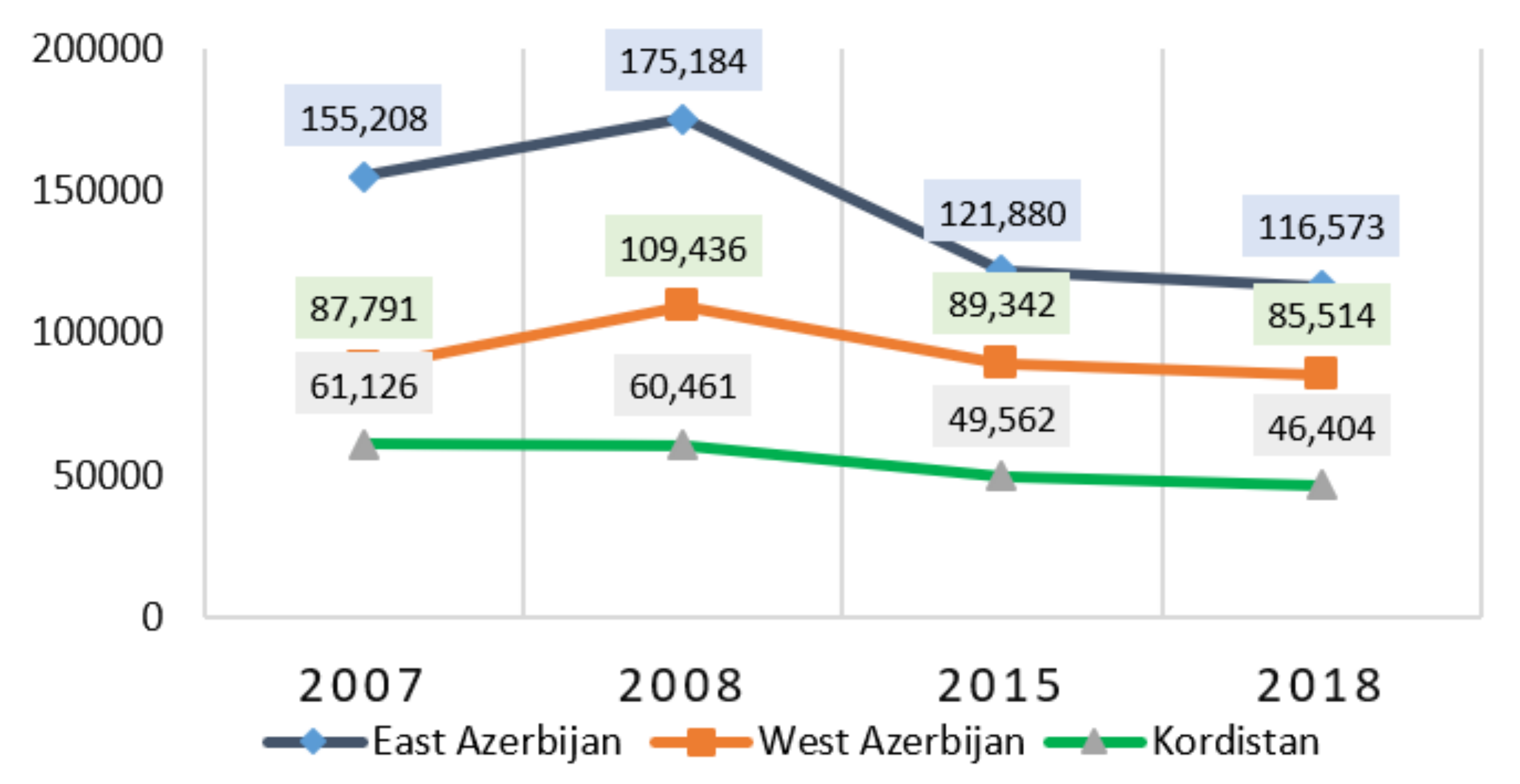

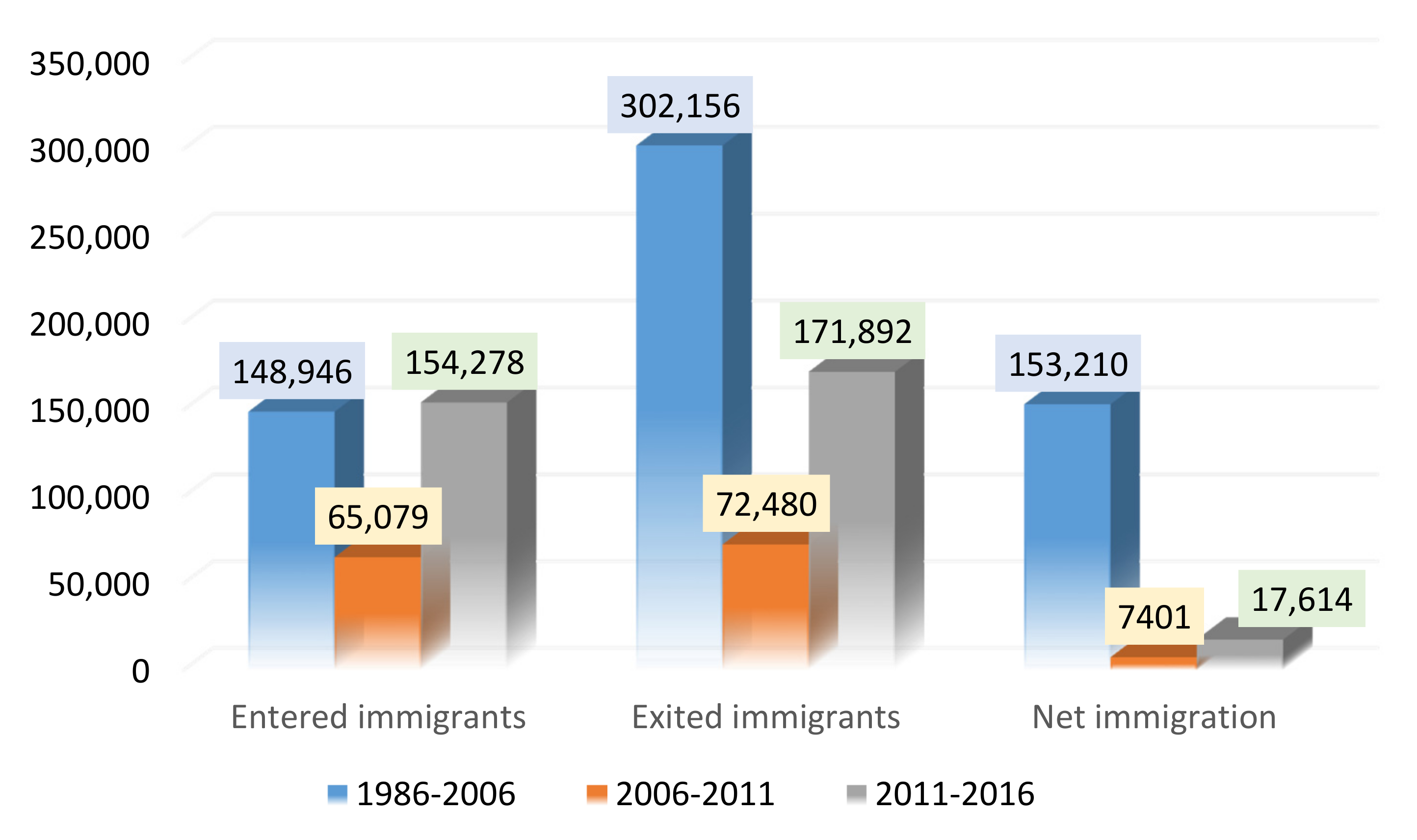
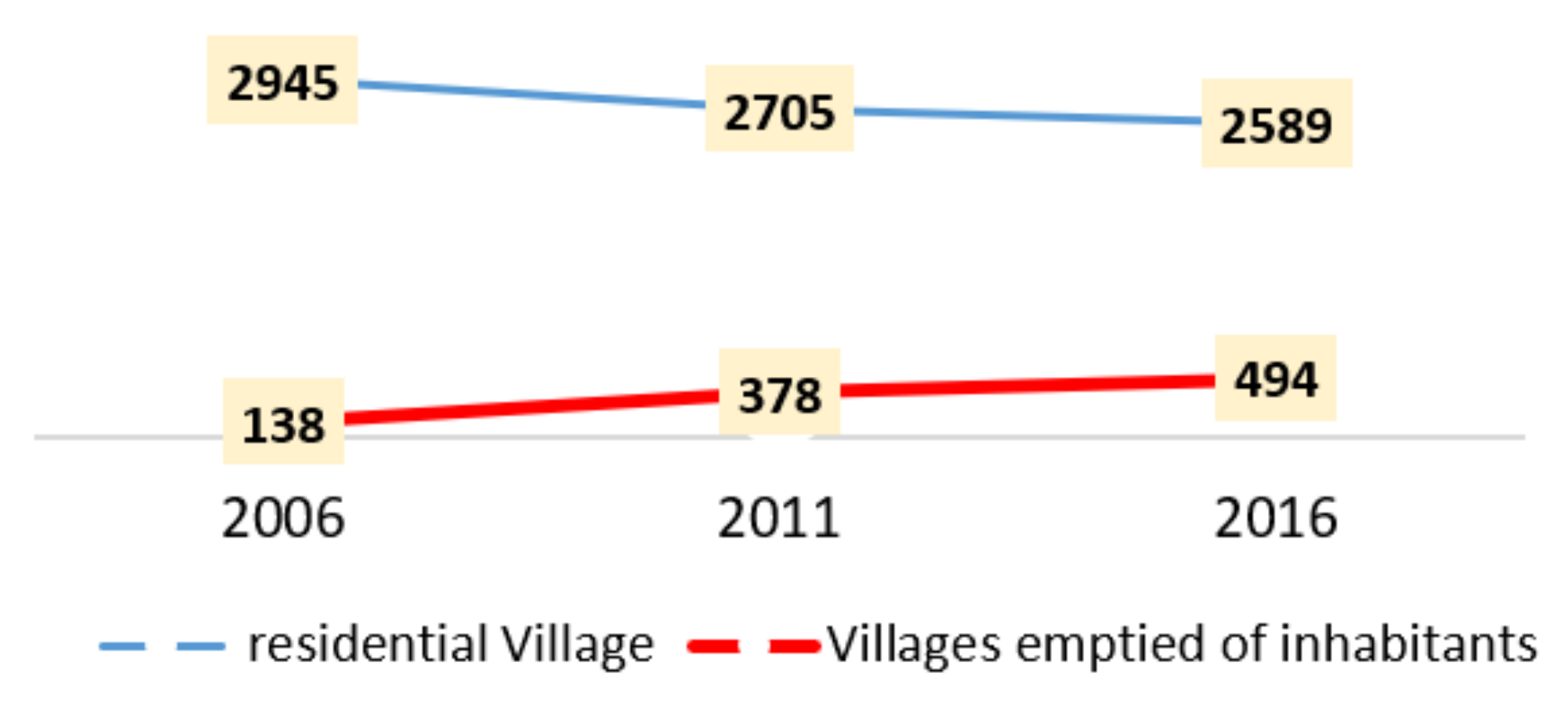
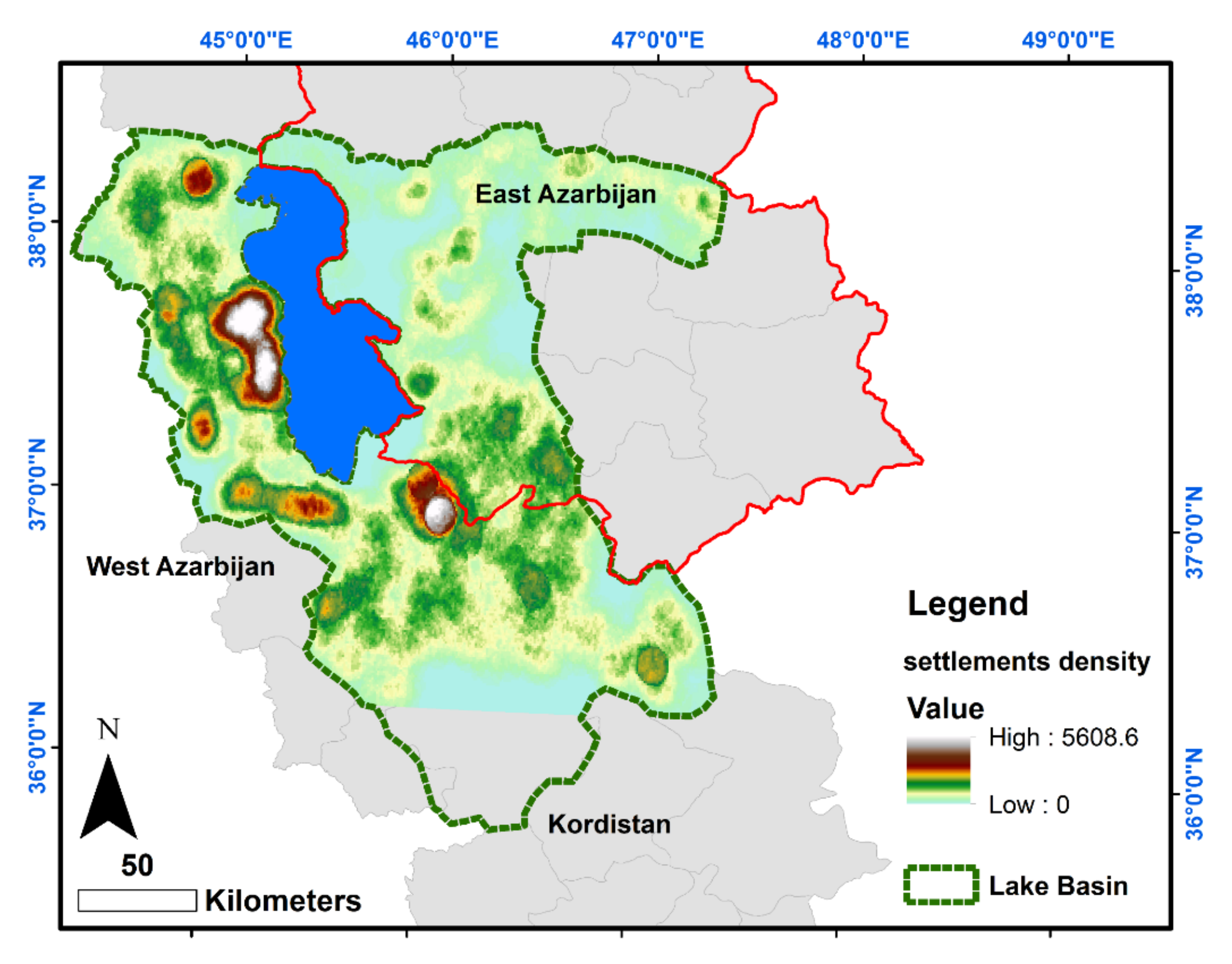
| Attributes | Description | ||||||
|---|---|---|---|---|---|---|---|
| Social | Settlement | Population | |||||
| 3186 | 5 million | ||||||
| Village | 3150 | City | 69% | ||||
| City | 36 | Village | 31% | ||||
| Economic | GDP percent share | Employment sectors | |||||
| Service | 58 | Service sector | 39% | ||||
| Agriculture | 15 | Agriculture sector | 36% | ||||
| Industry | 27 | Industry sector | 25% | ||||
| Cultivation Status | |||||||
| Aquaculture | 39.6% | ||||||
| Rain-fed Agriculture | 60.4% | ||||||
| Ecological | Conservation status | Products | Services | Functions | |||
| Lake is a National Park, Protected since 1957 (No hunting area), Ramsar site, UNESCO Biosphere Reserve | Salt harvest, grazing for domestic animals, Artemia harvest, fishery) some satellite wetlands only), controlling saline underground waters, water-birds for hunting, reeds, fodder, medicinal herbs | Tourism/eco-tourism, recreation, education, training, research, therapeutic muds, cultural heritage | Lake: Biodiversity support, landscape, climatic moderation, pollution and sediment retention. Satellite Wetlands: Biodiversity support, landscape, ground water recharge, climatic moderation, pollutant and sediment retention | ||||
| Climate | Elevation (m) | Average annual daily temperature (°C) | Frost (Days) | Average Wind speed (Km/h) | Evapotranspiration (mm) | ||
| 1361 | Min | Ave. | Max | 101.0 | 2.9 | 1626 | |
| 16.7 | 12.1 | 17.6 | |||||
| Group | ID | Affiliation | Implementation |
|---|---|---|---|
| Urmia Lake Restoration centre Committee | X1 | Chairman House Agriculture Committee | XP |
| X2 | Head of Urmia Lake Restoration centre, East Azerbaijan province Branch | XP | |
| X3 | Member of the Social & Cultural Council of Urmia Lake Restoration centre | XP | |
| X4 | head of the National Wheat Farmers Foundation | Q | |
| X5 | Chairman of the Alternative Employment and Livelihood Committee of Urmia Lake Restoration centre | XP | |
| X6 | Head of the Lake Urmia Monitoring Department of Tabriz University | XP | |
| X7 | Chairman of the NGO Committee | XP | |
| X8 | Member of the Social & Cultural Council of Urmia Lake Restoration centre | XP | |
| X9 | Member of the Social & Cultural Council of Urmia Lake Restoration centre | XP | |
| Researchers who have worked on Aral sea and Lake Urmia. | X10 | Teaching Assistant at The University of British Columbia, As part of the NSERC ResNet Strategic Network | Q |
| X11 | institute of geology and geophysics, Uzbekistan Academy of Sciences | Q | |
| X12 | Faculty of Geography, Lomonosov Moscow State University(PhD) | Q | |
| X13 | Chief of Executing Office (Head), Agency for project implementation of the International Fund for the Aral Sea Saving | Q | |
| X14 | Head of Department, Urmia Lake Restoration Program-Sharif University of Technology | Q | |
| X15 | Professor (Assistant), Faculty of Natural Resources, Urmia University, Urmia, Iran. | Q | |
| X15 | Professor (Associate), KIMEP University, Kazakhstan | Q | |
| X16 | Head of Department, Urmia University, Urmia Lake Research Institute | Q | |
| X17 | Researcher, Department of Environmental Systems Science, ETH Zurich | Q | |
| X18 | Department of Climatology, Faculty of Geography and Planning, University of Tabriz | Q | |
| X19 | Department of Climatology, Faculty of Geography and Planning, University of Tabriz | Q | |
| X20 | Head of Department, Associate Professor in Climatology at University of Tehran | Q | |
| X21 | Professor of Climatology, University of Zanjan, Zanjan, | Q | |
| X22 | Professor of Natural Geography Department, University Of Mohaghegh Ardabili | Q | |
| X23 | Researcher, Department Of geography and urban planning, University of Zanjan | Q | |
| X24 | Researcher, Department of Political Geography, Kharazmi University | Q | |
| X25 | Researcher, Department of geography and urban-rural planning, University Of Mohaghegh Ardabili | Q | |
| NGOs members | X26 | Active member of Lake Urmia Environmental Saviors Institute | Q |
| X27 | Active member of Yam Yashil Qushachai Institute | I | |
| X28 | Active member of Tabriz Green Thinkers Association | I | |
| X29 | Active member of Iranian Environmental fans Association | Q | |
| X30 | Active member of Yam Yashil Qushachai Institute | Q | |
| X31 | Active member of Yam Yashil Qushachai Institute | Q | |
| P31 | Active member of Green Bio Collaborators Association | Q | |
| P32 | Active member of Green Hearts Association | Q | |
| P33 | Active member of ’ I’m Lake Urmia’ campaign | Q | |
| P34 | Active member of ’ I’m Lake Urmia’ campaign | Q | |
| P35 | Active member of ’ I’m Lake Urmia’ campaign | Q |
| N° | Long Label | Short Label |
|---|---|---|
| 1 | Increase Temperature | X1 |
| 2 | Extinction of Wildlife | X2 |
| 3 | Flood | X3 |
| 4 | Changing the Cultivation Pattern | X4 |
| 5 | Reducing Pasture area | X5 |
| 6 | Dust Storm | X6 |
| 7 | Soil and Water Salinity | X7 |
| 8 | Groundwater Decline and Depletion | X8 |
| 9 | Air pollution | X9 |
| 10 | Plant Extinction Species | X10 |
| 11 | Drought | X11 |
| 12 | Destruction of Surrounding Agricultural Lands | X12 |
| 13 | Incidence of Different types of Diseases (respiratory, skin diseases, and various cancers) | X13 |
| 14 | Threat of the Food Chain | X14 |
| 15 | Disruption in Ecosystem Structure of lake | X15 |
| 16 | Desertification | X16 |
| 17 | Decreased Livability in Surrounding Cities | X17 |
| X1 | X2 | X3 | X4 | X5 | X6 | X7 | X8 | X9 | X10 | X11 | X12 | X13 | X14 | X15 | X16 | X17 | |
| X1 | 0 | 2 | 1 | 2 | 0 | 1 | 0 | 2 | 0 | 0 | 0 | 0 | 1 | 1 | 0 | 0 | 2 |
| X2 | 0 | 0 | 0 | 0 | 3 | 0 | 2 | 1 | 0 | 0 | 0 | 3 | 2 | 0 | 2 | 2 | 0 |
| X3 | 0 | 1 | 0 | 0 | 3 | 2 | 3 | 1 | 2 | 3 | 3 | 2 | 2 | 3 | 3 | 3 | 1 |
| X4 | 0 | 1 | 3 | 0 | 3 | 3 | 1 | 3 | 0 | 1 | 1 | 2 | 3 | 2 | 3 | 2 | 0 |
| X5 | 2 | 0 | 2 | 3 | 0 | 3 | 1 | 3 | 0 | 2 | 2 | 0 | 3 | 3 | 0 | 0 | 2 |
| X6 | 0 | 1 | 1 | 1 | 0 | 0 | 0 | 0 | 0 | 0 | 0 | 0 | 0 | 0 | 1 | 0 | 3 |
| X7 | 0 | 1 | 0 | 3 | 1 | 2 | 0 | 2 | 0 | 0 | 0 | 0 | 1 | 1 | 0 | 2 | 0 |
| X8 | 0 | 1 | 0 | 2 | 2 | 1 | 1 | 0 | 0 | 0 | 1 | 0 | 3 | 0 | 0 | 0 | 3 |
| X9 | 0 | 0 | 1 | 0 | 0 | 0 | 0 | 0 | 0 | 0 | 2 | 0 | 0 | 1 | 0 | 1 | p |
| X10 | 1 | 2 | 3 | 3 | 3 | 3 | 3 | 2 | 3 | 0 | 3 | 3 | 3 | 3 | 3 | 3 | 2 |
| X11 | 2 | 1 | 2 | 0 | 1 | 0 | 0 | 0 | 0 | 0 | 0 | 0 | 0 | 2 | 2 | 3 | 2 |
| X12 | 1 | 3 | 2 | 1 | 0 | 0 | 0 | 0 | 0 | 3 | 3 | 0 | 1 | 2 | 1 | 2 | 3 |
| X13 | 0 | 2 | 2 | 3 | 2 | 2 | 0 | 2 | 0 | 1 | 1 | 2 | 0 | 1 | 2 | 1 | 3 |
| X14 | 0 | 2 | 3 | 3 | 1 | 3 | 0 | 2 | 0 | 3 | 1 | 1 | 0 | 0 | 1 | 1 | 0 |
| X15 | 2 | 1 | 2 | 1 | 0 | 0 | 0 | 0 | 1 | 1 | 1 | 2 | 0 | 1 | 0 | 0 | 2 |
| X16 | 2 | 2 | 0 | 1 | 1 | 1 | 0 | 0 | 0 | 0 | 0 | 0 | 0 | 0 | 0 | 0 | 3 |
| X17 | 0 | 0 | 0 | 0 | 0 | 0 | 0 | 0 | 0 | 0 | 2 | 0 | 0 | 0 | 0 | 0 | 0 |
Publisher’s Note: MDPI stays neutral with regard to jurisdictional claims in published maps and institutional affiliations. |
© 2021 by the authors. Licensee MDPI, Basel, Switzerland. This article is an open access article distributed under the terms and conditions of the Creative Commons Attribution (CC BY) license (https://creativecommons.org/licenses/by/4.0/).
Share and Cite
Hamidi, S.M.; Fürst, C.; Nazmfar, H.; Rezayan, A.; Yazdani, M.H. A Future Study of an Environment Driving Force (EDR): The Impacts of Urmia Lake Water-Level Fluctuations on Human Settlements. Sustainability 2021, 13, 11495. https://doi.org/10.3390/su132011495
Hamidi SM, Fürst C, Nazmfar H, Rezayan A, Yazdani MH. A Future Study of an Environment Driving Force (EDR): The Impacts of Urmia Lake Water-Level Fluctuations on Human Settlements. Sustainability. 2021; 13(20):11495. https://doi.org/10.3390/su132011495
Chicago/Turabian StyleHamidi, Somayeh Mohammadi, Christine Fürst, Hossein Nazmfar, Ahad Rezayan, and Mohammad Hassan Yazdani. 2021. "A Future Study of an Environment Driving Force (EDR): The Impacts of Urmia Lake Water-Level Fluctuations on Human Settlements" Sustainability 13, no. 20: 11495. https://doi.org/10.3390/su132011495
APA StyleHamidi, S. M., Fürst, C., Nazmfar, H., Rezayan, A., & Yazdani, M. H. (2021). A Future Study of an Environment Driving Force (EDR): The Impacts of Urmia Lake Water-Level Fluctuations on Human Settlements. Sustainability, 13(20), 11495. https://doi.org/10.3390/su132011495







